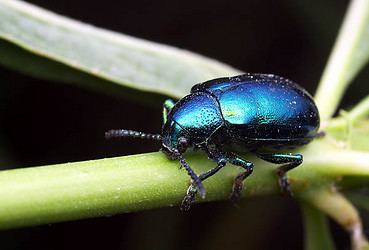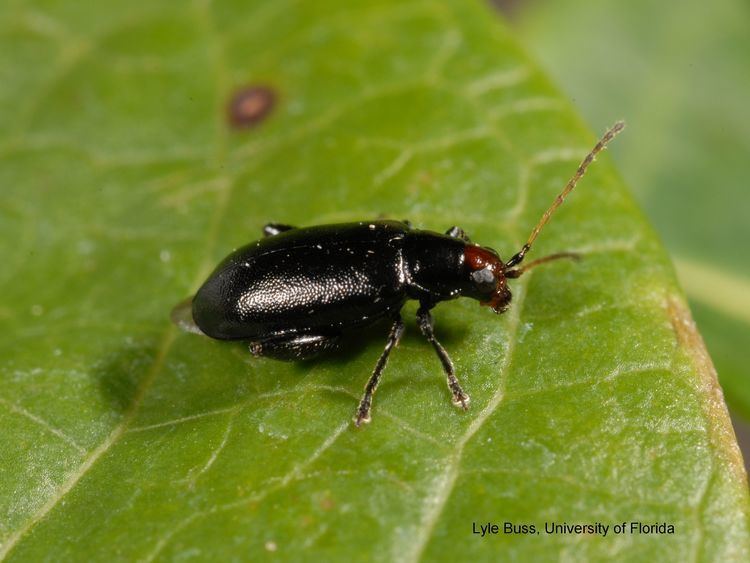Order Beetle | Suborder Polyphaga Scientific name Chrysomelidae Higher classification Chrysomeloidea | |
 | ||
Family ChrysomelidaeLatreille, 1802 Lifespan Callosobruchus maculatus: 10 – 14 days Lower classifications Flea beetle, Colorado potato beetle, Cassidinae, Chrysolina, Bean weevil | ||
Diabrotica bivittula cucurbit beetle chrysomelidae galerucinae leaf beetle species
The family Chrysomelidae, commonly known as leaf beetles, includes over 37,000 (and probably at least 50,000) species in more than 2,500 genera, making it one of the largest and most commonly encountered of all beetle families. Numerous subfamilies are recognized, but only some of them are listed below and the precise taxonomy and systematics are likely to change with ongoing research.
Contents
- Diabrotica bivittula cucurbit beetle chrysomelidae galerucinae leaf beetle species
- Leaf beetles micro presence book chrysomelidae insect japanese 0796
- Description
- Subfamilies
- Predators
- References

Leaf beetles are partially recognizable by their tarsal formula, which appears to be 4-4-4, but is actually 5-5-5 as the 4th tarsal segment is very small and hidden by the 3rd. As with many taxa, there is no single character that defines the Chrysomelidae; instead it is delineated by a set of characters. Some lineages are only distinguished with difficulty from longhorn beetles (family Cerambycidae), namely by the antennae not arising from frontal tubercles.

Adult and larval leaf beetles feed on all sorts of plant tissue, and all species are fully herbivorous. Many are serious pests of cultivated plants, for example the Colorado potato beetle (Leptinotarsa decemlineata), the asparagus beetle (Crioceris asparagi), the cereal leaf beetle (Oulema melanopus), and various flea beetles, and a few act as vectors of plant diseases. Others are beneficial due to their use in biocontrol of invasive weeds. Some Chrysomelidae are conspicuously colored, typically in glossy yellow to red or metallic blue-green hues, and some (especially Cassidinae) have spectacularly bizarre shapes. Thus, they are highly popular among insect collectors.
Leaf beetles micro presence book chrysomelidae insect japanese 0796
Description

The imagos of leaf beetles are small to medium-sized, i.e. most species range from 1 to 18 mm in length, excluding appendages, with just a few larger species such as Alurnus humeralis which reaches 35 mm. The bodies of most species are domed, and oval in dorsal view (though some are round or elongate), and they often possess a metallic luster or multiple colors. In most specimens the antennae are notably shorter than head, thorax and abdomen, i.e. not more than half their combined length. The second antennal segment is of normal size (which differentiates leaf beatles from the closely related longhorn beetles). In most species, the antennal segments are of a more or less equal shape, at most they gradually widen towards the tip, although some Galerucinae in particular have modified segments, mainly in males. The first segment of the antenna in most cases is larger than the following ones. The pronotum of leaf beetles varies between species. In most it is slightly to highly domed and trapezoidal to rounded-squarish in dorsal view. In some subfamilies such as the Cassidinae and to a lesser extent the Cryptocephalinae, the head is covered by the pronotum and thus not visible from above. The first three sternites are not fused, instead being linked by mobile sutures. Most species possess wings, although the level of development and thus flight ability varies widely, including within a single species, and some are flightless with fused elytra.
Subfamilies
The family includes the following subfamilies:


Until recently, the subfamily Bruchinae was considered a separate family, while two former subfamilies are presently considered families (Orsodacnidae and Megalopodidae). Other commonly recognized subfamilies have recently been grouped with other subfamilies, usually reducing them to tribal rank (e.g., the former Alticinae, Chlamisinae, Clytrinae, Synetinae, and Hispinae).
Predators
Some species of wasps, such as Polistes carolina, have been known to prey upon Chrysomelidae larvae after the eggs are laid in flowers.
